StATS: What is independence?
Independence is a critical concept in Statistics. Two events are said to be
independent if one event's occurence does not influence the probability that
the other event will or will not occur.
Testing independence using cell probabilities.
Two events are independent if the probability of both events occuring
together is equal to the product of the two individual probabilities.
In other words, is the probability in the cell equal to the product of the
probabilities in the corresponding row and column totals.
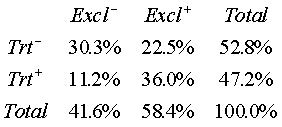
We can check this using the cell probabilities table. In the example shown
above, the events NG Tube and Exclusive are NOT independent. The probability
of NG Tube and Exclusive is 0.360. The product of the two individual
probabilities is 0.584*0.472=0.2756.
Testing independence using conditional probabilities.
You can also test independence by checking to see if the conditional
probability of an event is equal to the unconditional probability.
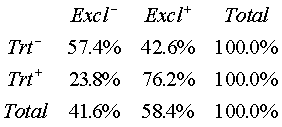
The table shown above has conditional probabilities for a breastfeeding
study. The rows represet the control and treatment groups respectively. The
columns represent bottle feeding and exclusive breastfeeding, respectively.
The events NG Tube and Exclusive are NOT independent. The conditional
probability,

whereas the unconditional probability,

is much smaller.
In the following fictional example, visitors to the Emergency Room are
classified as either arriving on a weekend or on a weekday. Further, visitors
are classified according to gender.
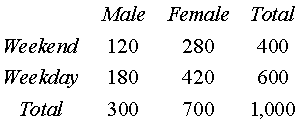
Shown above is the table of counts.
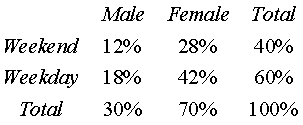
The events Male and Weekend are independent. The probability of both events
occuring (0.120) and the product of the two individual events (0.300*0.400)
are the same.
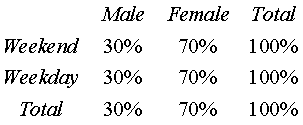
Another way of demonstrating this is noting that the conditional
probability (0.300) is the same as the unconditional probability (0.300).
Deducing independence through logic.
In some situations, you can deduce independence without resorting to
mathematics. If you can argue that it is impossible for one event to
influence the probability of a second event, then the two events are
logically independent.
Suppose, for example, that you randomly select two patients and watch them
for development of a certain disease. If the patients are not related (i.e.,
no common genetic patterns) and if the disease is not infectious then the
event that the first patient develops the disease is independent of the
second patient developing the same disease.
Independence among several events.
The idea of independence can be extended to several events. Several events
are said to be independent if the occurence of any one of the events does not
affect the probability that the other events will occur.
If the events

are independent events then the probability of all the events occuring
simultaneously is the product of the individual proababilities. In other
words,
![P[A1 and...and Ak] = P[A1] * ...* P[Ak]](images/indep17.gif)
If each of these independent events has the same probability (p), then the
formula simplifies to
![P[A1 and...and Ak] = p^k](images/indep18.gif) .
.
Example
In a study of chemotherapy for leukemia, we discover that of the 14 boys in
the study, none showed evidence of abnormal testicular function.
If the 14 boys are independent and if the probability of developing
abnormal testicular function after chemotherapy were 3% for each boy, what is
the chance that we would see 0 out of 14 in our sample?
![P[not abnormal for boy i] = .97](images/indep19.gif)
![P[not abnormal for all 14]=(.97)14=.65](images/indep20.gif)
A probability of 3% is reasonably consistent with what we saw in the
sample.
A variation on this example.
Suppose the probability of developing abnormal testicular function after
chemotherapy were 30%?
![P[not abnormal for all 14]=(.70)^14=.0068](images/indep21.gif)
This probability is much smaller. Under this assumption, it is unlikely to
see no abnormal testicular function in a sample of 14 boys. A probability of
30% is not reasonably consistent with what we saw in the sample.
This page was written by
Steve Simon while working at Children's Mercy Hospital. Although I do not hold the copyright for this material, I am reproducing it here as a service, as it is no longer available on the Children's Mercy Hospital website. Need more
information? I have a page with general help
resources. You can also browse for pages similar to this one at Category: Definitions,
Category: Probability concepts.




